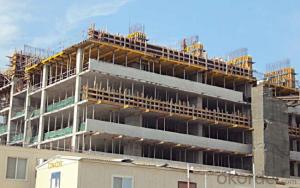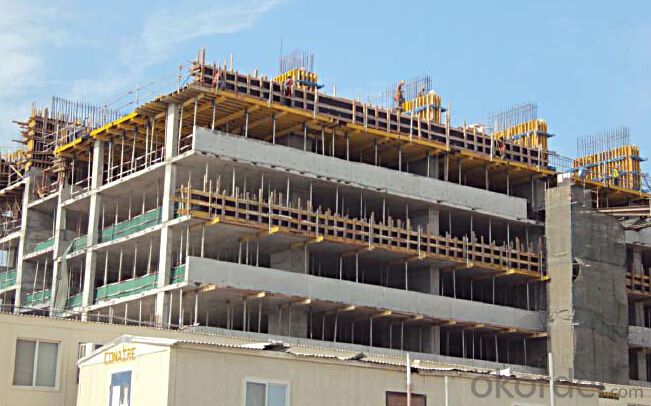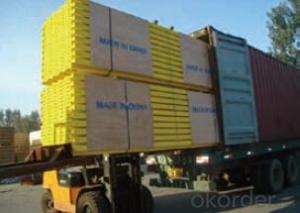Timber Beam Formwork H20 for formwork and scaffolding system
- Loading Port:
- Tianjin
- Payment Terms:
- TT OR LC
- Min Order Qty:
- 50 m²
- Supply Capability:
- 1000 m²/month
OKorder Service Pledge
OKorder Financial Service
You Might Also Like
Characteristics:
◆ Standardized production lines.
Supply capability: 3000m/day, Lmax = 6600mm.
◆ Finger jointing of the flange and web, the strength of timber beam is highly improved.
Max. shearing force failure load:40KN
◆ Well treated to prevent from water penetration or erosion, so the service life maximally
extended.
Normally, CNBM timber beam H20 can be used for 4 to 5 years, the exact using time would
depend on maintenance & storage.
◆ Robust caps at the end of the girders protect against damages.
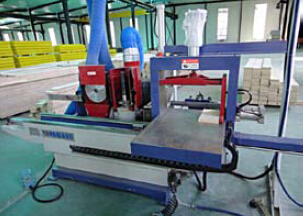


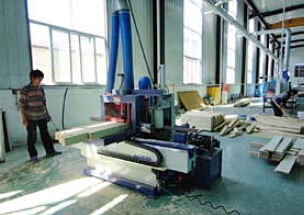
- Q: Can steel formwork be used for both thin and thick concrete elements?
- Yes, steel formwork can be used for both thin and thick concrete elements. Steel formwork is versatile and can be adjusted to accommodate different sizes and shapes of concrete elements. It provides strong and durable support, making it suitable for various construction projects.
- Q: Can steel formwork be used for both straight and curved concrete elements?
- Steel formwork is suitable for both straight and curved concrete elements. Its versatility allows for easy adjustment and shaping to meet various design needs. With its excellent strength and durability, steel formwork is perfect for constructing both straight and curved elements. Its flexibility allows for the creation of complex shapes, making it ideal for projects that require curved elements like architectural features, curved walls, or circular structures. Furthermore, steel formwork ensures a smooth and uniform surface finish, guaranteeing high-quality concrete results for both straight and curved elements.
- Q: What are the different types of steel formwork available?
- There are several types of steel formwork available in the construction industry, each with its own unique features and advantages. Some of the most common types include: 1. Modular steel formwork: This type of formwork consists of prefabricated steel panels that can be assembled and disassembled easily. It is customizable and can be used for various shapes and sizes of concrete structures. 2. Tunnel formwork: As the name suggests, tunnel formwork is used for constructing tunnels and underground structures. It is made of steel plates and is designed to withstand high pressure and provide a smooth finish to the concrete. 3. Climbing formwork: This type of formwork is used for tall structures like skyscrapers. It is designed to be lifted and moved vertically as the construction progresses. Climbing formwork provides safety and efficiency while constructing multi-story buildings. 4. Steel soldier formwork: This is a versatile and cost-effective type of formwork that is commonly used for walls and columns. It is made of steel beams and soldiers and can be easily adjusted to different heights and widths. 5. Steel frame formwork: This type of formwork is made of steel frames with plywood or metal panels attached to it. It is lightweight, easy to handle, and provides a smooth finish to the concrete. 6. Steel table formwork: This is a type of formwork that is used for large horizontal slabs. It consists of steel tables that are supported by props or scaffolding. Steel table formwork is quick to assemble and dismantle, making it ideal for projects with tight timelines. These are just a few examples of the different types of steel formwork available. The choice of formwork depends on the specific requirements of the construction project, such as the type of structure, load-bearing capacity, and desired finish.
- Q: How does steel formwork handle concrete bleeding and segregation?
- Steel formwork is known for its ability to effectively handle concrete bleeding and segregation. Bleeding refers to the process where water in the concrete mixture rises to the surface, leaving behind a layer of water on top. Segregation, on the other hand, occurs when the solid particles in the concrete mixture separate from the water, resulting in an uneven distribution. Steel formwork helps to minimize bleeding and segregation by providing a rigid structure that holds the concrete in place during the pouring and curing process. The tight joints and sturdy construction of steel formwork prevent the concrete from leaking or seeping out, thus reducing bleeding. Additionally, steel formwork allows for better control over the concrete placement and compaction process. The smooth and non-absorbent surface of steel formwork helps in achieving a uniform distribution of the concrete mixture, reducing the risk of segregation. The use of steel formwork also allows for proper vibration and consolidation of the concrete, helping to eliminate any potential voids or air pockets that may contribute to segregation. Furthermore, steel formwork provides stability during the curing process, ensuring that the concrete remains in its desired position without any significant movement. This stability helps to prevent any potential disturbances that could lead to bleeding or segregation. In summary, steel formwork is highly effective in handling concrete bleeding and segregation due to its rigid structure, tight joints, smooth surface, and stability. Its use promotes a more uniform and consolidated concrete placement, resulting in a higher quality finished product.
- Q: Can steel formwork be used for commercial construction projects?
- Yes, steel formwork can be used for commercial construction projects. Steel formwork offers durability, strength, and the ability to withstand heavy loads, making it a suitable choice for large-scale construction projects such as commercial buildings. It provides a stable and reusable solution that allows for efficient and precise concrete placement, ensuring high-quality results.
- Q: Can steel formwork be used for museum construction projects?
- Museum construction projects can indeed utilize steel formwork. Steel formwork provides a versatile and durable option for constructing various structures, including museums. It boasts multiple advantages, such as its remarkable strength, adjustable sizes, reusability, and ease of assembly and disassembly. With steel formwork, construction becomes precise and accurate, guaranteeing the quality and integrity of the museum's design. Furthermore, steel formwork can bear the weight of concrete and deliver a polished finish, which is vital for preserving the museum's aesthetic charm. In summary, steel formwork is an appropriate choice for museum construction projects as it offers strength, adaptability, and the ability to meet specific project requirements.
- Q: What are the environmental considerations of using steel formwork?
- When considering the environmental impact of using steel formwork, several factors need to be taken into account. Firstly, the production of steel involves the extraction of iron ore, which can have negative environmental consequences. Mining activities can lead to deforestation, habitat destruction, and soil erosion. Additionally, the extraction process requires a significant amount of energy, often obtained from non-renewable sources, contributing to greenhouse gas emissions. Another environmental consideration is the transportation of steel formwork. Steel is a heavy material, and moving it from the manufacturing site to the construction site can result in increased fuel consumption and emissions. This is especially true in cases where the construction site is located far from the steel manufacturing facility. However, it is important to note that steel formwork can have several environmental advantages as well. Steel is a durable material that can be reused multiple times, reducing the need for new formwork production. This helps to minimize the demand for raw materials and reduces waste generation. Steel formwork can also be easily recycled at the end of its lifespan, further reducing the environmental impact. Moreover, steel formwork is known for its strength and stability, which can result in more efficient construction processes. This can lead to reduced construction time and lower energy consumption during the building phase. To mitigate the environmental impact of using steel formwork, it is important to prioritize sustainable practices throughout its lifecycle. This includes sourcing steel from responsible suppliers who prioritize environmental stewardship, promoting recycling and reuse of formwork, and optimizing transportation and logistics to reduce carbon emissions. Overall, while there are environmental considerations associated with using steel formwork, its durability, reusability, and recyclability make it a viable option for sustainable construction practices when managed responsibly.
- Q: Can steel formwork be used for shopping mall construction projects?
- Indeed, shopping mall construction projects can utilize steel formwork. The utilization of steel formwork is widespread in construction projects owing to its durability, strength, and adaptability. It provides a robust and inflexible framework capable of withstanding the pressures inherent in shopping mall construction projects. Furthermore, steel formwork allows for effortless customization and alteration, which proves advantageous when constructing intricate structures such as shopping malls. Furthermore, steel formwork yields a polished and top-notch finish, guaranteeing that the end result satisfies the aesthetic prerequisites of a shopping mall. In essence, steel formwork proves to be a suitable alternative for shopping mall construction projects due to its robustness, endurance, versatility, and aesthetic allure.
- Q: Can steel formwork be used for both above-ground and below-ground structures?
- Yes, steel formwork can be used for both above-ground and below-ground structures. Steel formwork is known for its strength, durability, and versatility, making it suitable for various construction projects. Above-ground structures, such as buildings and bridges, often require formwork to shape and support the concrete during the casting process. Steel formwork provides the necessary strength and stability to withstand the weight and pressure of the concrete. Similarly, below-ground structures like basements, tunnels, and foundations can also benefit from steel formwork. These structures often require formwork to create the desired shape and provide support during the concrete pouring and curing phases. Steel formwork can withstand the pressure exerted by the surrounding soil and groundwater, ensuring the integrity of the structure. Moreover, steel formwork offers advantages such as reusability, easy assembly and disassembly, and the ability to withstand harsh environmental conditions. These characteristics make it an ideal choice for both above-ground and below-ground construction projects, where durability and efficiency are crucial. However, it is important to consider the specific requirements of each project and consult with structural engineers and construction experts to ensure the appropriate formwork system is selected.
- Q: What are the different types of steel used for formwork construction?
- There are several types of steel commonly used for formwork construction, including mild steel, high-strength low-alloy (HSLA) steel, and reinforced steel. These different types of steel offer varying levels of strength and durability, allowing for the construction of formwork that can withstand the pressures and forces exerted during the concrete pouring process.
Send your message to us
Timber Beam Formwork H20 for formwork and scaffolding system
- Loading Port:
- Tianjin
- Payment Terms:
- TT OR LC
- Min Order Qty:
- 50 m²
- Supply Capability:
- 1000 m²/month
OKorder Service Pledge
OKorder Financial Service
Similar products
Hot products
Hot Searches
Related keywords

